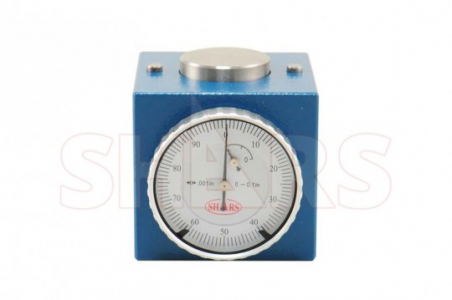-
Welcome back Guest! Did you know you can mentor other members here at H-M? If not, please check out our Relaunch of Hobby Machinist Mentoring Program!
You are using an out of date browser. It may not display this or other websites correctly.
You should upgrade or use an alternative browser.
You should upgrade or use an alternative browser.
Finding top edge
- Thread starter Maplehead
- Start date
There are also gages like this from Shars


 www.shars.com
www.shars.com


Precision Magnetic Z Axis Zero Setter 2" Height x 0.001"
A sharpy mark or light coat of dykem. Turn the mill by hand until the mark just disappears. back up a couple of tenths and move over and try again. A little practice and you can get to where you just wipe off the sharpy. You should be within a few tenths of the top. If you are actually milling the top, go for a very thin scratch line and you should be around a thousand or so, about what you get with the paper method.
You still have to debur and mic the piece when you get close to finish size.
You still have to debur and mic the piece when you get close to finish size.
- Joined
- Jan 6, 2017
- Messages
- 1,248
- Joined
- Feb 1, 2015
- Messages
- 9,995
It depends upon your desired accuracy and the equipment you have. I use Tormach's TTS system on both my Tormach CNC mill and my RF30 clone. The tools are loaded into ER20 holders and I can predetermine offsets off the machine. I use a tenths reading digital dial indicator for locating the surface and for zeroing a digital height gage. The tool offsets are then measured with the height gage and recorded in the tool offset table on the CNC mill or as appropriate subdatum points on the RF30 clone DRO.
For a more expedient approach, I will bring a tool down to just touch the surface as indicated by a light scratch. This will get me to within a thou. I have used the feeler gage and the paper method too and they are usually with a few thou or better. For less critical ops like drilling, i will just etball the tip of the tool. Drilling depth callouts traditionally are done to the shoulder of the drill and the distance from the shoulder to the tip can vary depending upon the width of the web and angle pf the cutting edge so there can be a fair amount of variation anyway.
For a project that I did some fifteen years ago, before the CNC mill, I made a sensitive version of the Z axis zero setter using a relay contact. The contact was set up outside the work zone and I could zero each new tool using the incremental setting on the DRO. This was useful as the original surface of the part was modified with previous machining steps which prevented zeroing on the part. I used the relay contact because I was using tools with diameters as small as .005" and over shoot by a small amount would have destroyed the tool on a standard tool setter.
For a more expedient approach, I will bring a tool down to just touch the surface as indicated by a light scratch. This will get me to within a thou. I have used the feeler gage and the paper method too and they are usually with a few thou or better. For less critical ops like drilling, i will just etball the tip of the tool. Drilling depth callouts traditionally are done to the shoulder of the drill and the distance from the shoulder to the tip can vary depending upon the width of the web and angle pf the cutting edge so there can be a fair amount of variation anyway.
For a project that I did some fifteen years ago, before the CNC mill, I made a sensitive version of the Z axis zero setter using a relay contact. The contact was set up outside the work zone and I could zero each new tool using the incremental setting on the DRO. This was useful as the original surface of the part was modified with previous machining steps which prevented zeroing on the part. I used the relay contact because I was using tools with diameters as small as .005" and over shoot by a small amount would have destroyed the tool on a standard tool setter.
- Joined
- May 4, 2019
- Messages
- 822
With the mill spindle stopped move the part in X or Y while bringing the quill down. When you see a scratch on the part you are there.
- Joined
- Oct 14, 2013
- Messages
- 1,294
For a quick and dirty, just lower the quill by hand until the mill is touching the top.of the part. Lock the quill and call that "close to zero" ;-)
Sent from my SM-G892A using Tapatalk
Sent from my SM-G892A using Tapatalk
- Joined
- Jan 20, 2018
- Messages
- 5,922
This is what I do. Don't forget to zero the knee.For a quick and dirty, just lower the quill by hand until the mill is touching the top.of the part. Lock the quill and call that "close to zero" ;-)


